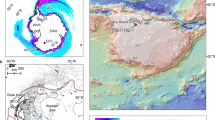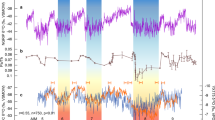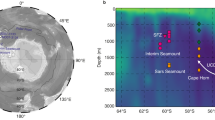Abstract
The causes for rising temperatures along the Antarctic Peninsula during the late Holocene have been debated, particularly in light of instrumental records of warming over the past decades1. Suggested mechanisms range from upwelling of warm deep waters onto the continental shelf in response to variations in the westerly winds2, to an influence of El Niño–Southern Oscillation on sea surface temperatures3. Here, we present a record of Holocene glacial ice discharge, derived from the oxygen isotope composition of marine diatoms from Palmer Deep along the west Antarctic Peninsula continental margin. We assess atmospheric versus oceanic influences on glacial discharge at this location, using analyses of diatom geochemistry to reconstruct atmospherically forced glacial ice discharge and diatom assemblage4 ecology to investigate the oceanic environment. We show that two processes of atmospheric forcing—an increasing occurrence of La Niña events5 and rising levels of summer insolation—had a stronger influence during the late Holocene than oceanic processes driven by southern westerly winds and upwelling of upper Circumpolar Deepwater. Given that the evolution of El Niño–Southern Oscillation under global warming is uncertain6, its future impacts on the climatically sensitive system of the Antarctic Peninsula Ice Sheet remain to be established.
This is a preview of subscription content, access via your institution
Access options
Subscribe to this journal
Receive 12 print issues and online access
$259.00 per year
only $21.58 per issue
Buy this article
- Purchase on Springer Link
- Instant access to full article PDF
Prices may be subject to local taxes which are calculated during checkout


Similar content being viewed by others
References
Russell, A. & McGregor, G. R. Southern hemisphere atmospheric circulation: Impacts on Antarctic climate and reconstructions from Antarctic ice core data. Climatic Change 99, 155–192 (2010).
Bentley, M. J. et al. Mechanisms of Holocene palaeoenvironmental change in the Antarctic Peninsula region. Holocene 19, 51–69 (2009).
Shevenell, A. E., Ingalls, A. E., Domack, E. W. & Kelly, C. Holocene Southern Ocean surface temperature variability west of the Antarctic Peninsula. Nature 470, 250–254 (2011).
Taylor, F. & Sjunneskog, C. Postglacial marine diatom record of the Palmer Deep, Antarctic Peninsula (ODP Leg 178, Site 1089), 2, diatom assemblages. Paleoceanography 17, 8001 (2002).
Makou, M. C., Eglinton, T. I., Oppo, D. W. & Hughen, K. A. Postglacial changes in El Niño and La Niña behavior. Geology 38, 43–46 (2010).
Yeh, S-W. et al. El Niño in a changing climate. Nature 461, 511–514 (2009).
Meredith, M. P. & King, J. C. Rapid climate change in the ocean west of the Antarctic Peninsula during the second half of the 20th century. Geophys. Res. Lett. 32, L19604 (2005).
Cook, A. J., Fox, A. J., Vaughan, D. G. & Ferrigno, J. G. Retreating glacier fronts on the Antarctic Penisula over the past half-century. Science 308, 541–544 (2005).
Barker, P. F. et al. Proceedings of ODP, Initial Reports, 178 (CD-ROM) (Ocean Drilling Program, Texas A&M University, College Station, 1999).
Heroy, D. C. & Anderson, J. B. Radiocarbon constraints on Antarctic Peninsula Ice Sheet retreat following the Last Glacial Maximum (LGM). Quat. Sci. Rev. 26, 3286–3297 (2007).
Domack, E. et al. Chronology of the Palmer Deep site, Antarctic Peninsula: A Holocene paleoenvironmental reference for the circum-Antarctic. Holocene 11, 1–9 (2001).
Kilfeather, A. A. et al. Ice-stream retreat and ice-shelf history in Marguerite Trough, Antarctic Penisula: Sedimentological and foraminiferal signatures. Geol. Soc. Am. Bull. 123, 997–1015 (2011).
Milliken, K. T., Anderson, J. B., Wellner, J. S., Bohaty, S. M. & Manley, P. L. High-resolution Holocene climate record from Maxwell Bay, South Shetland Islands, Antarctica. Geol. Soc. Am. Bull. 121, 1711–1725 (2009).
Debret, M. et al. Evidence from wavelet analysis for a mid-Holocene transition in global climate forcing. Quat. Sci. Rev. 28, 2675–2688 (2009).
Lamy, F. et al. Holocene changes in the position and intensity of the southern westerly wind belt. Nature Geosci. 3, 695–699 (2010).
Roberts, S. J. et al. The Holocene history of George VI Ice Shelf, Antarctic Peninsula from clast-provenance analysis of epishelf sediments. Palaeogeogr. Palaeoclimatol. Palaeoecol. 259, 258–283 (2008).
Moy, C. M., Seltzer, G. O. & Rodbell, D. T. Variability of El Niño/Southern Oscillation activity at millennial timescales during the Holocene epoch. Nature 420, 162–165 (2002).
Domack, E. W. in Proc. Ocean Drilling Program, Leg 178, Scientific Results (eds Barker, P. F., Camerlenghi, A., Acton, G. D. & Ramsay, A. T. S.) (Ocean Drilling Program, Texas A&M University, 2002).
Chazen, C. R., Altabet, M. A. & Herbert, T. D. Abrupt mid-Holocene onset of centennial-scale climate variability on the Peru-Chile Margin. Geophys. Res. Lett. 36, L18704 (2009).
Conroy, J. L., Overpeck, J. T., Cole, J. E., Shanahan, T. M. & Steinitz-Kannan, M. Holocene changes in eastern tropical Pacific climate inferred from a Galápagos lake sediment record. Quat. Sci. Rev. 27, 1166–1180 (2008).
Willmott, V. et al. Holocene changes in Proboscia diatom productivity in shelf waters of the north-western Antarctic Peninsula. Ant. Sci. 22, 3–10 (2010).
Leventer, A. et al. Productivity cycles of 200–300 years in the Antarctic Peninsula region: Understanding linkages among the sun, atmosphere, oceans, sea ice, and biota. Geol. Soc. Am. Bull. 108, 1626–1644 (1996).
Khider, D., Stott, L. D., Emile-Geay, J., Thunell, R. & Hammond, D. E. Assessing El Niño Southern Oscillation variability during the last millennium. Paleoceanography 26, PA3222 (2011).
Berger, A. & Loutre, M. F. Insolation values for the climate of the last 10 million years. Quat. Sci. Rev. 10, 297–317 (1991).
Ding, Q., Steig, E. J., Battisti, D. J. & Küttel, M. Winter warming in West Antarctica caused by central tropical Pacific warming. Nature Geosci. 4, 398–403 (2011).
Renwick, J. A. Persistent positive anomalies in the Southern Hemisphere circulation. Mon. Weath. Rev. 133, 977–988 (2005).
Pritchard, H. D. et al. Antarctic ice-sheet loss driven by basal melting of ice shelves. Nature 484, 502–505 (2012).
Meredith, M. P. et al. Changes in freshwater composition of the upper ocean west of the Antarctic Peninsula during the first decade of the 21st century. Prog. Oceanogr. 87, 127–143 (2010).
Maddison, E. J., Pike, J., Leventer, A. & Domack, E. W. Deglacial seasonal and sub-seasonal diatom record from Palmer Deep, Antarctica. J. Quat. Sci. 20, 435–446 (2005).
Swann, G. E. A., Pike, J., Snelling, A. & Leng, M. J. Seasonally resolved diatom δ18O records from the west Antarctic Peninsula over the last deglaciation. Earth Planet. Sci. Lett.http://dx.doi.org/10.1016/j.epsl.2012.12.016 (in the press).
Acknowledgements
We thank H. J. Sloane for assistance with the isotope analyses, I. M. Thomas for assistance with wavelet analysis, staff at the IODP Gulf Coast Core Repository for assistance with sampling ODP Site 1098 and S. Barker, C. Sjunneskog and M. Meredith for discussions. This research was supported by Natural Environment Research Council grants NE/G004811/1 awarded to J.P. and NE/G004137/1 awarded to M.J.L. and G.E.A.S.
Author information
Authors and Affiliations
Contributions
J.P., M.J.L. and G.E.A.S. conceived the project. A.M.S. and G.E.A.S. performed the δ18Odiatom analyses. J.P. performed the wavelet analysis and wrote the manuscript. All authors contributed to interpretations and commented on the manuscript.
Corresponding author
Ethics declarations
Competing interests
The authors declare no competing financial interests.
Supplementary information
Supplementary Information
Supplementary Information (PDF 515 kb)
Rights and permissions
About this article
Cite this article
Pike, J., Swann, G., Leng, M. et al. Glacial discharge along the west Antarctic Peninsula during the Holocene. Nature Geosci 6, 199–202 (2013). https://doi.org/10.1038/ngeo1703
Received:
Accepted:
Published:
Issue Date:
DOI: https://doi.org/10.1038/ngeo1703
This article is cited by
-
Fluctuating sea-level and reversing Monsoon winds drive Holocene lagoon infill in Southeast Asia
Scientific Reports (2023)
-
Stability of the Antarctic Ice Sheet during the pre-industrial Holocene
Nature Reviews Earth & Environment (2022)
-
Holocene melting of the West Antarctic Ice Sheet driven by tropical Pacific warming
Nature Communications (2022)
-
Sensitivity of Holocene East Antarctic productivity to subdecadal variability set by sea ice
Nature Geoscience (2021)
-
The marine geological imprint of Antarctic ice shelves
Nature Communications (2019)



